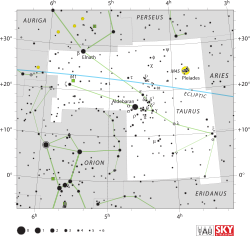
| |
| Observation data Epoch J2000.0 Equinox J2000.0 (ICRS) | |
|---|---|
| Constellation | Taurus |
| Right ascension | 04 24 05.75985 |
| Declination | +17° 26′ 38.8583″ |
| Apparent magnitude (V) | +4.80 |
| Characteristics | |
| Spectral type | A2 Vs |
| U−B color index | +0.12 |
| B−V color index | +0.15 |
| Astrometry | |
| Radial velocity (Rv) | +37.1 km/s |
| Proper motion (μ) | RA: +108.16 mas/yr Dec.: −34.66 mas/yr |
| Parallax (π) | 20.21 ± 0.40 mas |
| Distance | 161 ± 3 ly (49.5 ± 1.0 pc) |
| Absolute magnitude (MV) | +1.62 |
| Details | |
| Mass | 1.79 M☉ |
| Radius | 1.8 R☉ |
| Luminosity | 27 L☉ |
| Surface gravity (log g) | 4.15 cgs |
| Temperature | 7,997 K |
| Metallicity | +0.14 dex |
| Rotational velocity (v sin i) | 42 km/s |
| Age | 449 Myr |
| Other designations | |
| δ Tau, 64 Tauri, BD+17°714, HD 27819, HIP 20542, HR 1380, SAO 93907 | |
| Database references | |
| SIMBAD | data |
Delta Tauri (δ Tauri) is a solitary, white-hued star in the zodiac constellation of Taurus. Based upon an annual parallax shift of 20.21 mas as seen from Earth, it is located roughly 161 light years distant from the Sun. It is separated from δ Tauri by 0.3° on the sky and is faintly visible to the naked eye with an apparent visual magnitude of +4.80. The star is considered a member of the Hyades cluster.
At the estimated age of 449 million years, this is an A-type main-sequence star with a stellar classification of A2 Vs, where the 's' suffix indicates narrow (sharp) absorption lines. It has 1.8 times the mass of the Sun and about 1.8 times the Sun's radius. The star is radiating 27 times the Sun's luminosity from its photosphere at an effective temperature of 7,997 K.
δ Tauri is a source of X-ray emission with a luminosity of 101.1×10 W. Since A-type stars are not normally a source of X-rays, this emission may be coming from an unknown companion or from a line of sight source.
References
- ^ van Leeuwen, F. (2007), "Validation of the new Hipparcos reduction", Astronomy and Astrophysics, 474 (2): 653–664, arXiv:0708.1752, Bibcode:2007A&A...474..653V, doi:10.1051/0004-6361:20078357, S2CID 18759600.
- ^ Johnson, H. L.; et al. (1966), "UBVRIJKL photometry of the bright stars", Communications of the Lunar and Planetary Laboratory, 4 (99): 99, Bibcode:1966CoLPL...4...99J.
- ^ Paunzen, E.; et al. (July 2001), "A spectroscopic survey for λ Bootis stars. II. The observational data", Astronomy and Astrophysics, 373 (2): 625–632, Bibcode:2001A&A...373..625P, doi:10.1051/0004-6361:20010630.
- ^ Gebran, M.; et al. (May 2016), "A new method for the inversion of atmospheric parameters of A/Am stars", Astronomy & Astrophysics, 589: 10, arXiv:1603.01146, Bibcode:2016A&A...589A..83G, doi:10.1051/0004-6361/201528052, S2CID 118549566, A83.
- Eggen, Olin J. (July 1998), "The Age Range of Hyades Stars", The Astronomical Journal, 116 (1): 284–292, Bibcode:1998AJ....116..284E, doi:10.1086/300413.
- ^ David, Trevor J.; Hillenbrand, Lynne A. (2015), "The Ages of Early-Type Stars: Strömgren Photometric Methods Calibrated, Validated, Tested, and Applied to Hosts and Prospective Hosts of Directly Imaged Exoplanets", The Astrophysical Journal, 804 (2): 146, arXiv:1501.03154, Bibcode:2015ApJ...804..146D, doi:10.1088/0004-637X/804/2/146, S2CID 33401607.
- ^ Pasinetti Fracassini, L. E.; et al. (February 2001), "Catalogue of Apparent Diameters and Absolute Radii of Stars (CADARS)", Astronomy and Astrophysics, 367 (2) (Third ed.): 521–524, arXiv:astro-ph/0012289, Bibcode:2001A&A...367..521P, doi:10.1051/0004-6361:20000451, S2CID 425754.
- ^ Zorec, J.; Royer, F. (2012), "Rotational velocities of A-type stars. IV. Evolution of rotational velocities", Astronomy & Astrophysics, 537: A120, arXiv:1201.2052, Bibcode:2012A&A...537A.120Z, doi:10.1051/0004-6361/201117691, S2CID 55586789.
- "del02 Tau". SIMBAD. Centre de données astronomiques de Strasbourg. Retrieved 2017-08-07.
- Eggleton, P. P.; Tokovinin, A. A. (September 2008), "A catalogue of multiplicity among bright stellar systems", Monthly Notices of the Royal Astronomical Society, 389 (2): 869–879, arXiv:0806.2878, Bibcode:2008MNRAS.389..869E, doi:10.1111/j.1365-2966.2008.13596.x, S2CID 14878976.
- O'Meara, Stephen James (2016), Deep-Sky Companions: The Caldwell Objects, Cambridge University Press, p. 195, ISBN 978-1107083974.
- Gebran, M.; Vick, M.; Monier, R.; Fossati, L. (November 2010), "Chemical composition of A and F dwarfs members of the Hyades open cluster", Astronomy and Astrophysics, 523: 13, arXiv:1006.5284, Bibcode:2010A&A...523A..71G, doi:10.1051/0004-6361/200913273, S2CID 7164596, A71.
- Schröder, C.; Schmitt, J. H. M. M. (November 2007), "X-ray emission from A-type stars", Astronomy and Astrophysics, 475 (2): 677–684, Bibcode:2007A&A...475..677S, doi:10.1051/0004-6361:20077429.